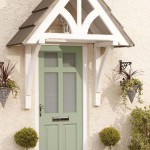 First impressions count – quite literally, when it comes to opening up your home to visitors! You may not realise it, but the colour of your front door might say more about you than you think!
First impressions count – quite literally, when it comes to opening up your home to visitors! You may not realise it, but the colour of your front door might say more about you than you think!
According to home website www.newhomefinder.co.uk, your front door reveals more than just your entrance hall. So if you are about to move or if imminent home improvement plans involve a new front door, you might want to read New Home FinderÔÇÖs guide first:
Red
Passionate red is vibrant, lively and exciting – and so too is the person behind the door. People who choose to paint their front door red are amongst the most hospitable souls, delighting in entertaining guests. A red door says ÔÇÿwelcomeÔÇÖ – and means it!
Orange
Orange is the colour of warmth, expressing energy, happiness and confidence. A blend of the primary colours red and yellow, it represents a mixture both – the happiness of yellow and the boldness of red – and people with an orange door are often social butterflies.
Yellow
Yellow is the colour of logic and represents the left side of the brain, which is responsible for critical thinking and original thought. As the lightest colour in the spectrum it also inspires feelings of cheerfulness, fun and positivity. People living behind a yellow door have a vitality for life and a ÔÇÿget up and goÔÇÖ attitude!
Green
 You might expect a whole lotta shakinÔÇÖ to be going on behind the green door, but in fact it represents tranquility and tradition. Green is the colour of health and wealth, and people with a green door are often successful and ambitious, valuing the wellbeing of their family, hard work hard and self improvement.
You might expect a whole lotta shakinÔÇÖ to be going on behind the green door, but in fact it represents tranquility and tradition. Green is the colour of health and wealth, and people with a green door are often successful and ambitious, valuing the wellbeing of their family, hard work hard and self improvement.
Blue
Relaxing, calming and honest, blue is the colour of peace. Those who choose a blue front door see their home as a refuge from the outside world and tend to be grounded, honest and true to themselves.
Brown
The colour of earth, brown is warm, stable and organic. Whether the door is painted brown or is natural wood, the person behind it will share the same characteristics, being grounded, down to earth, warm and friendly. But darker brown can reflect a private soul, trying to avoid too much interaction.
Black
The colour of sophistication, black is classic, authoritative and stylish. Painting your front door black is a bold statement to the world that your home is a place of order and control. Anyone living behind a black front door is likely to have a place for everything, with everything in its place.
White
White is the colour of perfection, symbolising wholeness, equality and creativity. People with a white door will be fair, balanced and also highly imaginative, able to fill the blankness of white with ideas and creativity.
Glass
Last but by no means least, the person with a glass door is like the glass itself – friendly, outgoing and open!
If reading this has made you think your own main entrance could do with a revamp, read our handy guide on how to freshen up your front door.



 This weekend, chances are youÔÇÖll either be jetting off for some late summer sunshine, sewing nametags into school uniforms or indulging in a spot of DIY. The three-day August bank holiday is the perfect chance to carry out a big project or several odd jobs ÔÇô but, unfortunately, this favourite hobby can all too often end in tears!
This weekend, chances are youÔÇÖll either be jetting off for some late summer sunshine, sewing nametags into school uniforms or indulging in a spot of DIY. The three-day August bank holiday is the perfect chance to carry out a big project or several odd jobs ÔÇô but, unfortunately, this favourite hobby can all too often end in tears! Quality counts
Quality counts